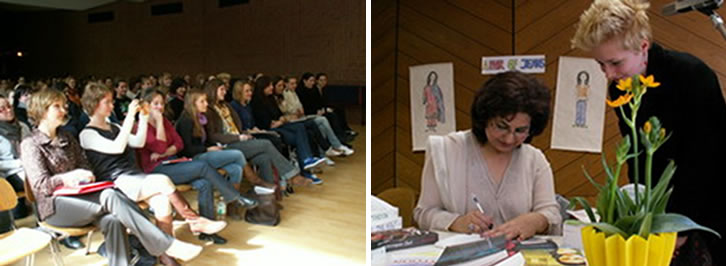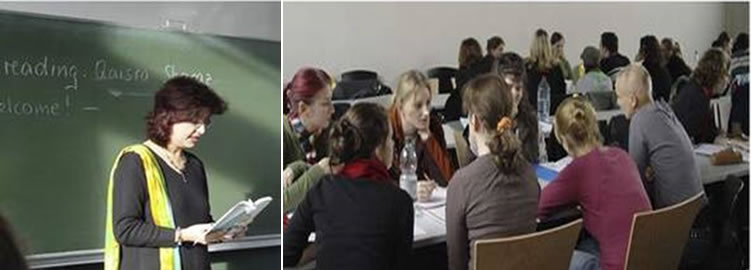A story behind my story ‘A Pair of Jeans’
A writer’s journey can sometimes be full of surprises. There is a story behind my short story ‘A Pair of Jeans’. Written long time ago, and included in 13 world-wide editions, with 8 in Germany, “A Pair of Jeans” is the very first piece of fiction I wrote. On maternity leave from my teaching job and pregnant with my first son, Farakh, I joined a local women’s writers group run by Manchester based publishers ‘Commonwords/Crocus Books’. We would meet every Tuesday afternoon and read our stories or poems to our fellow aspiring writers. Their enthusiasm and supportive feedback spurred me on to write other stories.
The writing course I was doing with the London School of Writing at the time encouraged us to write about what we knew best. As a young British Muslim woman of Pakistani origin growing up in the UK, I was fascinated by our lives – double lives in fact –in which we were able to slip in and out of our two personae on a daily basis.
Speaking to and signing copies for students at St Agnes Girls Gymnasium, Stuttgart
First published in the UK in 1988 in Holding Out, by Crocus Books, the short story explored the issue of clothing, female modesty, multiple identities and cultural clashes. In 1989 it was picked up by a German Professor/Editor, Dr. Liesel Hermes, as a literary text to be used in German schools in a collection entitled Writing Women; Twentieth Century Short Stories. Other authors included Virginia Woolf, Doris Lessing, and Margaret Drabble. These were the people I had studied. It was a very humbling experience.
I had not envisaged it being used as a literary text in another country. I was still learning my craft, putting pen to paper and letting ideas flow out of me. When the editor started to write a teacher’s guidebook and started to quiz me about my story’s content, analysing themes, characters, etc. I got cold feet. I became highly defensive – worried that the readers (students and teachers) would read far more into it than I had ever intended. For me it was just a story – pure fiction. For the readers it was potentially a mirror of a community. I decided to write a new ending, with a more positive outcome.
Prof. Hermes and later the German Education Ministry however, opted to keep both endings, cleverly reckoning that they provided a good discussion point and a comparing and contrasting writing exercise for the students. So it became a story with 2 endings. When ‘A Pair of Jeans’ became prescribed reading for the German Abitur English Literature exam in 2005, guess what I did? I had another bash at it – revising and updating it, making it more topical, with a new focus: the showing of the flesh. I was happier with this version.
Reading and discussion of ‘A Pair Of Jeans’ at Pädagogische Hochschule, Karlsruhe (University of Education) with literature teacher trainees
A story can take you round the world but if it leads to a better understanding of different global communities, and makes us get out of our little boxes, it is most welcome in present times.
Currently it is also being used as an academic text in universities in several countries including Morocco, Singapore, India and Pakistan. In a textbook on my work, ‘The Holy and The Unholy’, there are three academic papers on ‘A Pair of Jeans’. These include Battling Orthodox Eugenics: Reading “A Pair of Jeans” in Rabat, Morocco’ by Professor Mohammed Ezroura An article, ‘Reading Qaisra Shahraz’s ‘A Pair of Jeans” with German students’, by Professer Liesel Hermes, who originally introduced the story in Germany. In india Professor Shuby Abidi explored ‘The Mensahib Complex – Collision and Collusion of Identity’ and Dr Sami Rafiq also discussed ‘A Pair Of Jeans’ in her article ‘Grace under Pressure: An Exploration of Female Worlds in Qaisra Shahraz’s Short Stories’.

Munster, Germany
In my collection of short stories, The Elopement, The Discovery and A Pair of Jeans focus on intercultural issues; Miriam in A Pair of Jeans discovers that a seeming innocuous item of clothing can cause disaster while Rubiya in The Elopement and The Discovery pays the price of rejection for her past misdeed. In The Zemindar’s Wife and Perchanvah the reader opens a window into a world of feudal lifestyle and class consciousness that is embedded in the psyche of many of the country’s inhabitants. Escape and the City Dwellers explore the feelings of those struggling to discover the meaning of “home”, whilst The Malay Host is a contrast with an element of the mysterious. What is behind the one locked door in the old Malay house that is a tourist attraction and why is the woman of the house brandishing a piece of burning wood at the Western visitors?
This blog was written for Hope Road Publishing and can be found on their website where the collection ‘A Pair Of Jeans’ can also be purchased.


